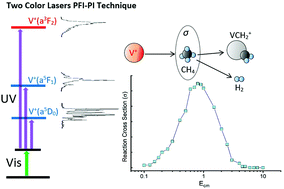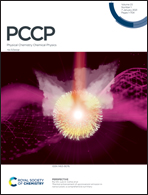Quantum electronic control on chemical activation of methane by collision with spin–orbit state selected vanadium cation
Abstract
By coupling a newly developed quantum-electronic-state-selected supersonically cooled vanadium cation (V+) beam source with a double quadrupole-double octopole (DQDO) ion–molecule reaction apparatus, we have investigated detailed absolute integral cross sections (σ's) for the reactions, V+[a5DJ (J = 0, 2), a5FJ (J = 1, 2), and a3FJ (J = 2, 3)] + CH4, covering the center-of-mass collision energy range of Ecm = 0.1–10.0 eV. Three product channels, VH+ + CH3, VCH2+ + H2, and VCH3+ + H, are unambiguously identified based on Ecm-threshold measurements. No J-dependences for the σ curves (σ versus Ecm plots) of individual electronic states are discernible, which may indicate that the spin–orbit coupling is weak and has little effect on chemical reactivity. For all three product channels, the maximum σ values for the triplet a3FJ state [σ(a3FJ)] are found to be more than ten times larger than those for the quintet σ(a5DJ) and σ(a5FJ) states, showing that a reaction mechanism favoring the conservation of total electron spin. Without performing a detailed theoretical study, we have tentatively interpreted that a weak quintet-to-triplet spin crossing is operative for the activation reaction. The σ(a5D0, a5F1, and a3F2) measurements for the VH+, VCH2+, and VCH3+ product ion channels along with accounting of the kinetic energy distribution due to the thermal broadening effect for CH4 have allowed the determination of the 0 K bond dissociation energies: D0(V+–H) = 2.02 (0.05) eV, D0(V+–CH2) = 3.40 (0.07) eV, and D0(V+–CH3) = 2.07 (0.09) eV. Detailed branching ratios of product ion channels for the titled reaction have also been reported. Excellent simulations of the σ curves obtained previously for V+ generated by surface ionization at 1800–2200 K can be achieved by the linear combination of the σ(a5DJ, a5FJ, and a3FJ) curves weighted by the corresponding Boltzmann populations of the electronic states. In addition to serving as a strong validation of the thermal equilibrium assumption for the populations of the V+ electronic states in the hot filament ionization source, the agreement between these results also confirmed that the V+(a5DJ, a5FJ, and a3FJ) states prepared in this experiment are in single spin–orbit states with 100% purity.



 Please wait while we load your content...
Please wait while we load your content...